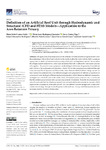Definition of an Artificial Reef Unit through Hydrodynamic and Structural (CFD and FEM) Models—Application to the Ares-Betanzos Estuary

Use this link to cite
http://hdl.handle.net/2183/30293Collections
- Investigación (EPEF) [590]
Metadata
Show full item recordTitle
Definition of an Artificial Reef Unit through Hydrodynamic and Structural (CFD and FEM) Models—Application to the Ares-Betanzos EstuaryAuthor(s)
Date
2022Citation
Galdo, M.I.L.; Guerreiro, M.J.R.; Vigo, J.L.; Rodriguez, I.A.; Lorenzo, R.V.; Couce, J.C.C.; Couce, L.C. Definition of an Artificial Reef Unit through Hydrodynamic and Structural (CFD and FEM) Models—Application to the Ares-Betanzos Estuary. J. Mar. Sci. Eng. 2022, 10, 230. https://doi.org/10.3390/jmse10020230
Abstract
[Abstract] The application of hydrodynamics to the definition of artificial reefs is of great interest since the positioning of the artificial reef modules on the sea floor alters the water velocity field, causing an appropriate circulation of nutrients and promoting a habitat for settling desired species. Nevertheless, the designs must be subjected to a structural calculation that will condition the constructive process to be applied. The present research proposes a methodology to determine the geometry of an artificial reef in terms of hydrodynamic and structural criteria. The solution proposed was analyzed through Computational Fluid Dynamics (CFD) and the Finite Element Method (FEM). Using concrete as base material for artificial reefs, four different dosages were proposed with different proportions of cement and water, leading to different mechanical properties, which determine different constructive strategies, such as dwell time in the mold. From the hydrodynamic point of view, it was found that the solution proposed provides a proper replacement of nutrients. From the structural point of view, it was found that the solution proposed does not need steel reinforcements in concrete, which improves the sustainability of the artificial reef. The four different concrete dosages will condition the constructive strategy through the dwelling time in the mold and, for any established production, the necessary number of molds (formworks).
Keywords
Artificial reef
Hydrodynamics
Structural analysis
Finite element method
Hydrodynamics
Structural analysis
Finite element method
Editor version
Rights
Atribución 4.0
ISSN
2077-1312






